
A Private Pilot License (PPL) allows you to fly an aircraft for non-commercial purposes. This comprehensive guide covers everything you need to know to obtain your PPL, from eligibility requirements to the final checkride.
1. Understanding the PPL
What is a PPL?
- A Private Pilot License (PPL) is a certification that allows the holder to act as the pilot-in-command of an aircraft privately and carry passengers, but not for compensation or hire.
Privileges of a PPL:
- Fly for personal or recreational purposes.
- Carry passengers.
- Operate under Visual Flight Rules (VFR).
2. Eligibility Requirements
Age:
- You must be at least 17 years old to obtain a PPL.
Language Proficiency:
- You must be able to read, speak, write, and understand English.
Medical Certificate:
- Obtain at least a third-class medical certificate from an Aviation Medical Examiner (AME).
3. Ground School
Purpose:
- Ground school provides the theoretical knowledge needed to pass the FAA written exam and to understand aviation principles and regulations.
Subjects Covered:
- Aerodynamics
- Aircraft systems
- Flight operations
- Weather and meteorology
- Navigation
- Air law and regulations
- Human factors and aeromedical issues
Learning Resources:
- Attend a flight school’s ground training program.
- Use online courses, textbooks, and study guides.
- Take practice exams to prepare for the written test.
4. Flight Training
Flight Hours Requirement:
- A minimum of 40 flight hours, including:
- 20 hours of flight training with an instructor.
- 10 hours of solo flight time.
- 5 hours of cross-country flight.
- 3 hours of night flying.
- 3 hours of instrument training.
Training Components:
- Pre-Solo: Learn basic maneuvers, takeoffs, landings, and emergency procedures.
- Solo Flight: Practice flying alone under the supervision of your instructor.
- Cross-Country: Plan and execute flights to different airports.
- Night Flying: Learn to fly in night conditions.
- Instrument Training: Learn to fly using only the aircraft’s instruments.
5. Choosing a Flight School
Factors to Consider:
- Location and weather conditions.
- Cost of training, including tuition, aircraft rental, and other fees.
- Reputation and reviews from past students.
- Quality and maintenance of the aircraft fleet.
- Qualifications and experience of the instructors.
- Facilities and equipment, including simulators.
Types of Flight Schools:
- Part 61: Offers more flexibility in training schedules and curriculum.
- Part 141: Follows a more structured curriculum and typically requires fewer flight hours.
6. Passing the Written Exam
Preparation:
- Complete ground school training.
- Study using textbooks, online courses, and practice exams.
The Exam:
- The FAA Private Pilot Knowledge Test consists of 60 multiple-choice questions.
- You must score at least 70% to pass.
7. Medical Certification
Obtaining a Medical Certificate:
- Schedule an appointment with an Aviation Medical Examiner (AME).
- Undergo a medical examination, which includes checking vision, hearing, and overall health.
Types of Medical Certificates:
- First-Class: Required for airline transport pilots.
- Second-Class: Required for commercial pilots.
- Third-Class: Sufficient for private pilots.
8. The Checkride (Practical Test)
Preparation:
- Ensure you have met all flight training requirements and logged the necessary hours.
- Perform a mock checkride with your instructor to prepare.
The Checkride Process:
- Oral Examination:
- Covers topics from the written test and your flight training.
- Expect questions on aerodynamics, aircraft systems, flight operations, weather, and navigation.
- Flight Test:
- Demonstrate your flying skills, including preflight preparation, takeoffs, landings, maneuvers, and emergency procedures.
- The examiner will evaluate your ability to operate the aircraft safely and competently.
Passing the Checkride:
- Successfully complete both the oral and flight portions of the checkride.
- If you pass, the examiner will issue a temporary PPL.
9. Maintaining Your PPL
Flight Review:
- Complete a flight review every 24 months with a certified flight instructor.
Recency of Experience:
- To carry passengers, you must have completed at least three takeoffs and landings within the preceding 90 days.
Currency Requirements:
- Stay current with your medical certificate.
- Regularly practice flying to maintain your skills and proficiency.
10. Tips for Success
Consistent Practice:
- Fly regularly to build and maintain your skills.
Stay Organized:
- Keep track of your flight hours, study materials, and progress.
Ask Questions:
- Don’t hesitate to ask your instructors for clarification or assistance.
Join a Community:
- Engage with other student pilots and experienced pilots for support and advice.
I’m a DevOps/SRE/DevSecOps/Cloud Expert passionate about sharing knowledge and experiences. I am working at Cotocus. I blog tech insights at DevOps School, travel stories at Holiday Landmark, stock market tips at Stocks Mantra, health and fitness guidance at My Medic Plus, product reviews at I reviewed , and SEO strategies at Wizbrand.
Do you want to learn Quantum Computing?
Please find my social handles as below;
Rajesh Kumar Personal Website
Rajesh Kumar at YOUTUBE
Rajesh Kumar at INSTAGRAM
Rajesh Kumar at X
Rajesh Kumar at FACEBOOK
Rajesh Kumar at LINKEDIN
Rajesh Kumar at PINTEREST
Rajesh Kumar at QUORA
Rajesh Kumar at WIZBRAND

